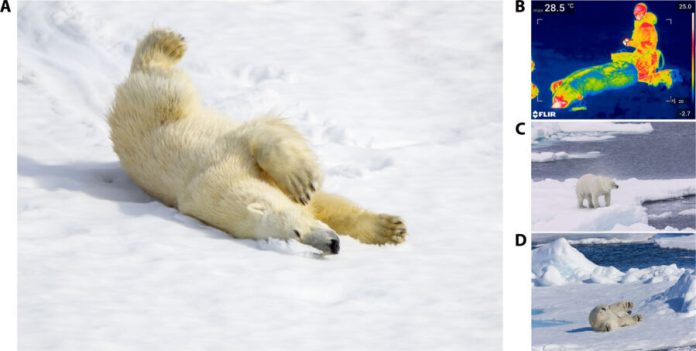Recent studies have revealed that polar bears have a natural ice-repelling mechanism in their fur that is as effective as synthetic anti-icing materials, offering a sustainable solution for preventing ice accumulation on aircraft wings and wind turbines. The research, published in Science Advances, demonstrates how these Arctic animals have developed a special oil coating that keeps their fur free of ice even in extremely cold temperatures of -40°C.
The scientists discovered that the bears’ fur functions similarly to advanced industrial anti-icing surfaces, thanks to a unique blend of natural oils known as sebum. When this protective coating was removed, the fur’s adhesion to ice increased significantly, emphasizing the importance of these natural compounds.
By using quantum chemical simulations, the team identified specific lipids within the sebum that form weak bonds with ice. Interestingly, polar bear fur lacks a compound called squalene, commonly found in other marine mammals, indicating a key evolutionary adaptation.
Dr. Marco Sacchi, Associate Professor at Surrey’s School of Chemistry and Chemical Engineering and co-author of the study, explains, “Certain lipids in the sebum, such as cholesterol and diacylglycerols, have very low adsorption energies on ice, preventing ice from sticking to the fur.”
This discovery is significant as industries seek sustainable alternatives to fluorocarbon-based anti-icing materials. The research suggests that untreated polar bear fur performs comparably to these industrial coatings, offering a more environmentally friendly solution.
Sacchi notes, “The absence of squalene, which strongly adheres to ice, enhances the fur’s ability to shed ice. It’s fascinating to see how evolution has optimized the composition of the sebum to prevent ice adhesion.”
Furthermore, the study validates traditional Indigenous knowledge. Arctic communities have long recognized the unique properties of polar bear fur and have integrated it into tools and clothing for ice hunting. Their traditional methods of preserving the fur’s natural oils demonstrate an intuitive understanding of its anti-icing properties.
This collaborative research, involving institutions from Norway, Ireland, the UK, and Denmark, utilized advanced analytical techniques to analyze the molecular composition of the bears’ fur coating. The findings have the potential to revolutionize ice prevention methods in various industries, including aviation and renewable energy.
If you found this information valuable, please consider supporting our work with a small, one-time or monthly donation. Your contribution allows us to continue delivering accurate, insightful science and medical news that you can rely on. Independent reporting requires time, effort, and resources, and your support enables us to delve into the important stories that impact you. Together, we can ensure that vital discoveries and advancements reach those who need them most.






